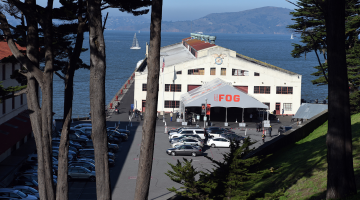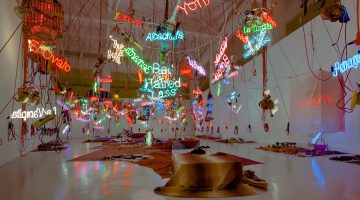David Zwirner Gallery’s recent group exhibition Folk Devil, curated by Associate Director Rodolphe von Hofmannsthal, didn’t exactly breach the conventions of the standard Chelsea group show, but I forgave it. Mostly tidy works occupy a stock exhibition plan and the show reads like a textbook summer sample platter: there’s intimidating work and creepy work, there’s something obtuse and something abstract; there are works that embody the standard gallery buzzwords: polished, raw, confrontational, humorous, beautiful, sublime. Nearing the end of group show season in Chelsea, I might typically scoff, or simply exit unimpressed, but I can’t this time. The work in this show was just TOO good.

BRIAN GRIFFITHS, THE BODY AND GROUND (OR YOUR BRITTLE SMILE), CANVAS, SCENIC ACRYLIC PAINT, ROPE, WEBBING, FIBERGLASS POLE, METAL POLES, VINTAGE TRAVEL SOUVENIR PATCHES, NET FABRIC, TARPAULIN, DUCT TAPE, THREAD, STRING, SAND AND FIXINGS, 137 3/4 X 228 3/8 X 177 1/4 IN., 2010. IMAGE COURTESY OF DAVID ZWIRNER GALLERY AND THE ARTIST.
This witches’ brew of disparate artists, utilizing divergent styles and varied craftsmanship, certainly lends itself to the thread this exhibition attempts to weave with the title Folk Devil. The press release explains that the title “borrows… from sociologist Stanley Cohen’s 1972 study Folk Devils and Moral Panics, which looked at modern society’s deep-rooted fear of subcultures and the morally aberrant.”

SOPHIE VON HELLERMANN, FIGHTING ON THE BEACH II, RAW PIGMENT AND ACRYLIC BINDER ON CANVAS, 90 1/2 X 126 IN., 2013. IMAGE COURTESY OF DAVID ZWIRNER GALLERY AND THE ARTIST.
Folk Devil IS a sexy title for a show, but the press release doesn’t connect any of the artists to particular “subcultures”, nor does it link the exhibition concept in any substantial way to Stanley Cohen’s work. The P.R. goes on to say that with this “… diverse group of artists, Folk Devil presents a comment on the tendency to create artificial connections between individuals with different backgrounds and no inherent commonality.” It doesn’t say what that comment is.

LYNETTE YIADOM-BOAKYE, DIVINING IN THE DARK, OIL ON CANVAS, 55 1/8 X 51 1/8, IN., 2013. IMAGE COURTESY OF LOUIS M SCHMIDT.
What’s more, so many galleries employ this sort of generic catchall with group shows- you all realize, right (?), that this is just the gallery’s open admission that they had no idea how to otherwise link the works they wanted to show, so they claim that the show is partly about artists who “no inherent commonality”. In other words, it’s an intellectual cop out. Or maybe it’s just lazy. I suppose I could give them the benefit of the doubt- it is Zwirner, after all, and I respect their program. Not that the gallery needs a bone thrown or anything, but maybe they just phoned in this one.

STEVEN SHEARER, POEMS X (DETAIL), INKJET PRINT, 47 1/2 X 34 1/2 IN., 2005. COURTESY OF DAVID ZWIRNER GALLERY AND THE ARTIST.
Well at any rate, the work in this show really is great- it had me from the moment I spotted Steven Shearer’s 2005 Poems X: a series of text-based inkjet prints, each with a different, mind-alteringly beautiful waterfall of ranting, blasphemous, obscene and graphic poetry. I might even imagine that, if Spartacus Chetwynd’s monstrous (yet comical?) Gatekeeper sculptures were perhaps representative of a human population reduced to base observations of the world around them, then these poems might be a key to their language. In fact, it’s not too hard to pick up an apocalyptic vibe amidst these works- while officially framed as youthful, rebellious and subcultural, the work all together is more akin to a testimonial incoherently muttered by the damaged, the forlorn and the forgotten.

SPARTACUS CHETWYND, GATEKEEPER (RED DRAGON) (DETAIL), PAPER, LATEX, PLASTIC AND FABRIC, 76 X 11 X 18 IN., 2011. IMAGE COURTESY OF DAVID ZWIRNER GALLERY AND THE ARTIST.
Another standout is Lynette Yiadom-Boakye’s beautiful 2013 oil painting Divining in the Dark, a medium-sized, understated portrait of a young girl facing away from the viewer. It is also half of the best juxtaposition in the show- the painting is placed on a diagonal from a colorful and provocative raw torso-esque sculpture by Franz West. The implication between the two works suggests both vulnerability and accusation; one body’s torso is passive yet alert, refusing to acknowledge viewers and wielding power in that denial; the other torso is chained and destroyed yet gorgeous and evocative of history, somehow classical.
An untitled 2013 work by Oscar Murillo is nailed to one of the back walls. Executed in oil and oil stick on un-stretched canvas, this large, asymmetric and nearly monochromatic black work conjures geographies as much as omens, like an aerial map of a country destroyed by a plague.

OSCAR MURILLO, UNTITLED, OIL AND OIL STICK ON CANVAS, 142 1/2 X 110 1/2 IN., 2013. IMAGE COURTESY OF DAVID ZWIRNER GALLERY AND THE ARTIST.
The work rests like evidence of a foreshadowing, with Marlene Dumas’s 1985 oil painting The White Disease right next to it, offering viewers further proof that, for reasons we pretend not to know, our self-made apocalypse continues its weary march through history: consuming some, stultifying and disfiguring others, and it won’t rest until Stanley Cohen’s social order has been sufficiently eradicated.

MARLENE DUMAS, THE WHITE DISEASE, OIL ON CANVAS, 51 1/4 X 43 1/2 IN., 1985. IMAGE COURTESY OF LOUIS M SCHMIDT.
Folk Devil closed on August 7, but you can still check it out online. Look up the artists. Google Stanley Cohen and try to connect the dots. By the by, Zwirner has a Raymond Pettibon show opening on September 12. I’ll probably need to write about that, too. Stay tuned.
-Contributed by Louis M. Schmidt







